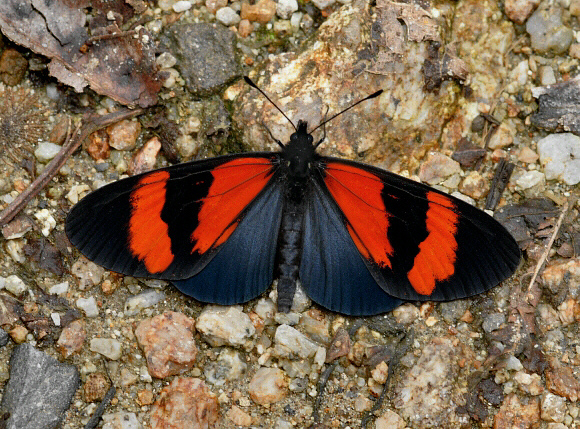 Altinote dicaeus callianira – it’s distinct pattern advertises it’s unpalatability – Adrian Hoskins
Altinote dicaeus callianira – it’s distinct pattern advertises it’s unpalatability – Adrian Hoskins
Aposematic colouration is a term used to describe colours and / or patterns that act as a warning to predators that a potential prey species is unpalatable, toxic or dangerous.
Various studies have shown that all vertebrates including insectivorous birds associate greens and blues with safety, and inherently regard red, orange, yellow and white as signs of danger. It is also widely accepted that patterns incorporating stripes or spots draw attention to objects.
Consequently it is no surprise to find that toxic or unpalatable butterflies have evolved colour schemes that reflect these facts, in order to “label” themselves as being unpleasant to eat, and thereby dissuade birds from attacking them. Equally it is unsurprising that a significant number of palatable species have evolved which mimic the patterns of toxic species, in order to trick birds into leaving them alone.
Birds can remember the colours and patterns of butterflies, and associate them with pleasurable or unpleasant experiences. If a bird pecks at a toxic butterfly it finds the taste very unpleasant, and is likely to suffer consequences including vomiting, nausea and visual disturbance. Experiments with various insectivorous birds have shown that if they suffer this experience they then avoid eating similarly coloured butterflies for several hours or days. Periodically they re-sample aposematically coloured butterflies, thereby reaffirming their unpalatability.
It has also been demonstrated that certain lizards e.g. those in the neotropical genus Amieva learn to recognise and avoid eating aposematic butterflies. Further study will quite possibly demonstrate that chameleons, tree frogs and other vertebrate insectivores react similarly.
Diematic patterns
Defensive markings which have the effect of startling or frightening potential predators are known as diematic patterns.
The commonest form of diematic defence is the use of ocelli. Usually these take the form of a pair of false-eye markings which can frighten away a predator, or at least startle it long enough for the insect to make it’s escape. In many butterflies and moths these ocelli are highly conspicuous and simulate the eyes of monkeys or raptors. Examples include Automeris Bullseye moths, Smerinthus Eyed Hawkmoths and the Peacock butterfly Inachis io. In others the ocelli are smaller and simulate the eyes of snakes or lizards. Field observations and laboratory experiments have confirmed that many insectivorous birds are deterred by aposematic and diematic markings.
In a study by Stockholm University, the ocelli of 20 Peacock butterflies Inachis io were blanked out with a marker pen. When exposed to blue tits, 13 of them were attacked and eaten. A control group of 34 Peacocks with intact ocelli fared much better – only a single butterfly was attacked. It can be concluded that in 97% of encounters with blue tits, the ocelli are effective as a deterrent.

Inachis io – very beautiful to human eyes, but frightening to a small bird – Adrian Hoskins
The neotropical Bullseye moths such as Automeris liberia, keep their ocelli hidden most of the time beneath their cryptically patterned “dead leaf” forewings. If disturbed they immediately drop to the ground and twitch rhythmically, drawing maximum attention to the ocelli. The appearance is quite fearsome, and more than enough to deter a bird from attacking.
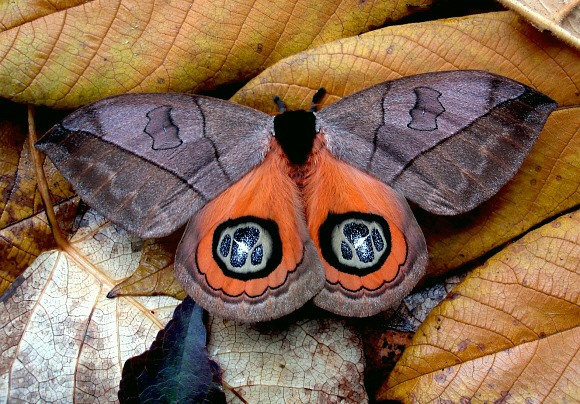
Automeris liberia, Ecuador – Steve Ife
Diematic mimicry is quite a common form of defence in caterpillars as well as in adult butterflies and moths. The larvae of many Swallowtail species including Papilio polymnester and Papilio troilus have a pair of false eye-spots on the thoracic segments. Many hawkmoth larvae such as Deilephila elpenor and Hippotion celerio employ the same strategy. When alarmed the larvae of these species puff up the thoracic segments causing the eye-spots to expand. This is considered to be a form of diematic defence in which the larvae are mimicking the heads of snakes.
Snake mimicry is also found in adult Atlas moths in the genera Attacus and Rothschildia. In these species the forewing apex is lobed, and bears markings corresponding to the eyes and mouth of a snake. The illusion is enhanced by rhythmic movements of the wings which draw attention to the snake-head markings.
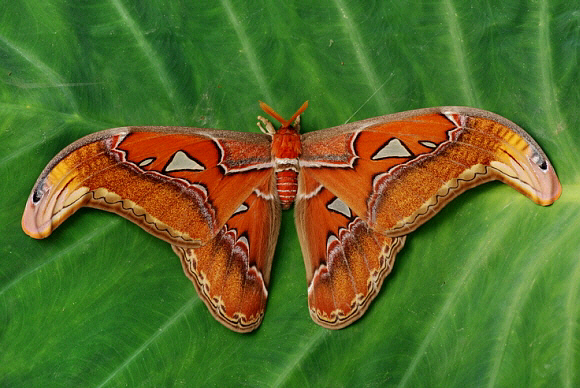
Snake-head markings on apex of Giant Atlas moth Attacus atlas – Gan Cheong Weei
Decoys to distract birds
Often the frightening effect of diematic markings is only temporary. Having gotten over the initial shock a bird may resume it’s attack. In such circumstances the ocelli on the butterfly’s wings take on a secondary defence role, diverting and confusing the predator :
When a bird attacks a butterfly it naturally focuses it’s aim on an obvious target area. The presence of a decoy target such as a false eye diverts the attack away from the butterfly’s body, towards the wing borders. Usually this results in nothing more than a small chunk being pecked out of the wing, and the insect escapes virtually unharmed.
It is not unusual to find ocelli-marked butterflies which have had chunks pecked out of their wings by birds. Butterflies are able to fly and go about their lives with quite large pieces missing from their wings, but an attack on their body would be fatal.
Sometimes the ocelli are huge, as in the neotropical Owl butterfly Caligo teucer, but even the small ocelli on species such as the Gatekeeper Pyronia tithonus are enough to divert a bird attack away from the butterfly’s body.
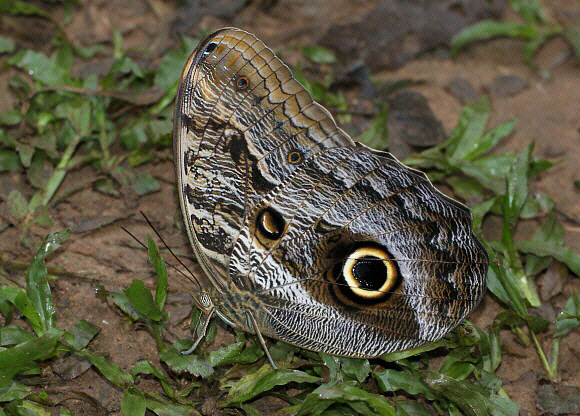
Caligo teucer, Peru -Adrian Hoskins
The Zebra Teaser Arawacus separata and many other butterflies in the subfamily Theclinae have wings that are marked with bright streaks which lead the eye away from their head, and towards antennae-like tails on their hindwings. In many species there is also a red or black spot near the tail, which simulates an eye.
The overall effect is to create the illusion of a “false head”, and to give the butterfly a back-to-front appearance. This is further enhanced by the butterfly’s habit of immediately turning to face the other way as soon as it lands on a flower or leaf. It is also likely to dip it’s real head, and raise the false head. Periodically, it oscillates the hindwings, causing the false-antennae tails to wriggle.
An attacking bird always tries to anticipate the escape route of it’s prey, so it aims it’s attack at a point fractionally in front of the head. The false head fools the bird into aiming behind the butterfly instead. The butterfly then darts off in the opposite direction to that which the bird expects, and makes it’s escape.
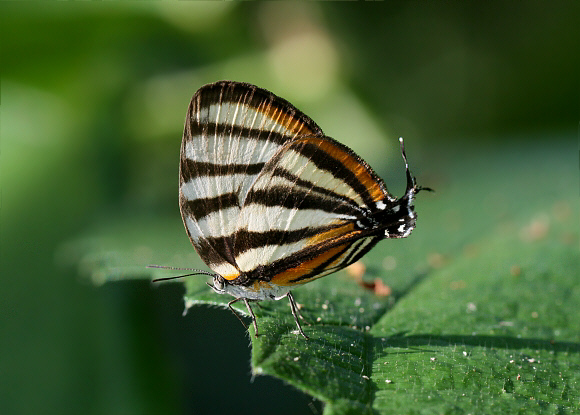 Arawacus separata – stripes give a back-to-front appearance, false antennae act as decoys
Arawacus separata – stripes give a back-to-front appearance, false antennae act as decoys
Patterns to confuse
Many butterflies have patterns which at first glance seem to serve no purpose. What for example would be the point of a striking and easily remembered pattern such as the chequered appearance of the Swallowtail Papilio machaon ?
Observing butterfly behaviour often reveals the answer to such riddles. The Swallowtail normally rests with it’s wings closed, but if it is disturbed it suddenly flicks them open in exactly the same manner as adopted by the Peacock and other ocelli-equipped species such as Bullseye Silkmoths or Eyed Hawkmoths. Furthermore, when alarmed the butterfly often moves the outspread wings in a jerky and almost threatening motion, as if to deliberately draw attention to itself.
It seems likely therefore that the pattern acts either to make the butterfly appear too large to eat, or that it simply confuses the bird – causing it’s eyes to wander all over the pattern while the bird tries to fathom out what it all means – Is it edible ? Is it dangerous ? Is it small enough to eat ? Which bit of it should I aim my beak at ? The bird may be so confused that it decides to abandon the attack, or the attack may simply be delayed long enough to allow the butterfly to escape.
The purpose of the crimson ocelli on the hindwings remains a mystery. They are not big enough to be scary, and their positioning close to the vulnerable body effectively rules out any possibility that they act as decoys or targets.
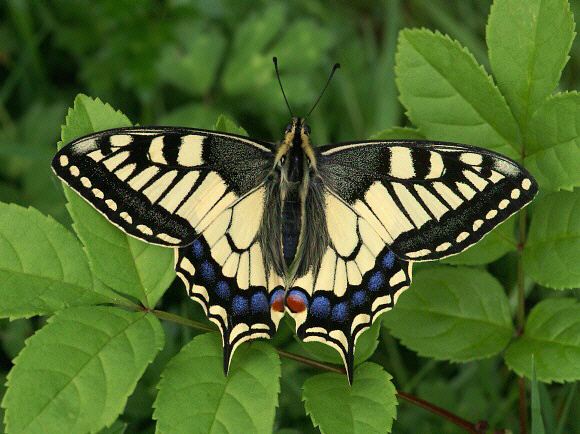
Papilio machaon flicks it’s wings open in a threatening manner if alarmed – Adrian Hoskins
Signalling danger to other butterflies
Warning colouration is generally assumed to be targeted directly at birds and other predators, but in the case of Panacea prola from Peru the purpose is quite different :
Large groups of males gather to feed on mineralised moisture on riverbanks. They bask when feeding, displaying their metallic blue uppersides, which help other passing males to locate them and home in on the feeding grounds.
A group of butterflies on the ground could easily be attacked by birds however, so the butterflies need to employ a defence strategy. Any kind of minor disturbance causes one or two butterflies to get twitchy, at which point they start fanning their wings nervously so that the bright red undersides are visible to the other butterflies.
Increased levels of nervousness cause them to fan their wings faster, which attracts the attention of further basking males, which join in the fanning activity. This “red for danger” signalling is a very effective alarm system. It quickly alerts all Panacea in the vicinity to any perceived threat, and allows them time to take evasive action before the threat becomes severe.
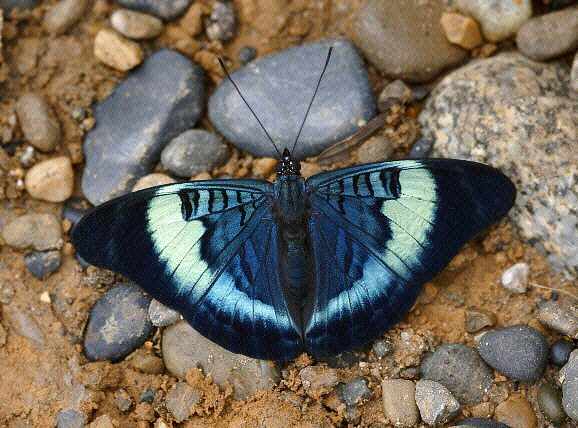 Panacea prola basks while feeding on mineralised water on a Peruvian riverbank – Adrian Hoskins
Panacea prola basks while feeding on mineralised water on a Peruvian riverbank – Adrian Hoskins
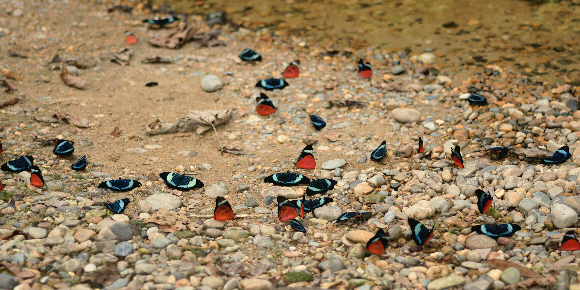 Panacea prola group wing-fanning to warn each other of potential danger – Adrian Hoskins
Panacea prola group wing-fanning to warn each other of potential danger – Adrian Hoskins
Flash Colouration
Many butterflies have a “now you see me, now you don’t” alternating display of a bright upperside and sombre underside. This is known as flash colouration.
An example is the South American Morpho helenor which has a brilliant iridescent blue upperside that makes it highly visible to predators as well as to potential mates. If alarmed, the butterfly will immediately land, snapping it’s wings shut so that only the dark brown underside is visible.
After landing however there is always the possibility that it might be spotted at rest by a pursuing bird, so then the secondary decoy-ocelli defence may help the butterfly to escape by diverting the birds beak away from the butterfly’s body and towards the wing edges.
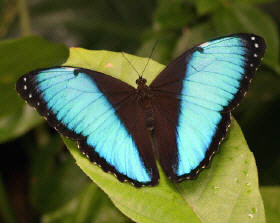 | 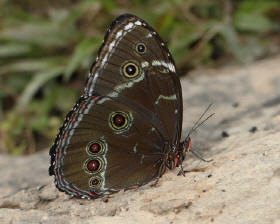 |
Morpho helenor -Adrian Hoskins
